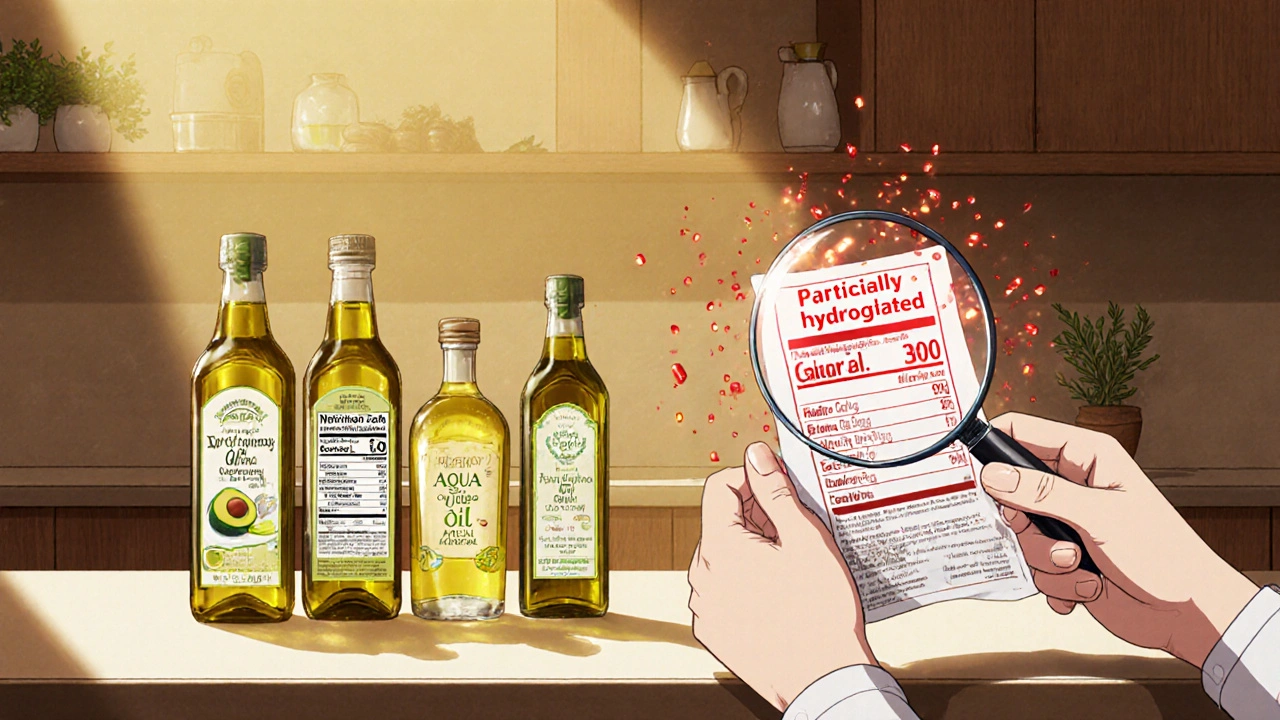What Makes an Oil Heart-Healthy?
Not all fats are created equal. Some fats raise your bad cholesterol and increase your risk of heart disease. Others do the opposite-they lower bad cholesterol, raise good cholesterol, and reduce inflammation. The difference comes down to the type of fat in the oil.
Heart-healthy oils are high in unsaturated fats, especially monounsaturated and omega-3 polyunsaturated fats. These fats help keep your arteries clear and your heart beating strong. The American Heart Association and the Heart Foundation of Australia both agree: replacing saturated fats with unsaturated fats can cut your risk of heart disease by up to 30%.
Look for oils with at least 55% monounsaturated fat and less than 15% saturated fat. Avoid anything with trans fats-those are the worst. Even if a label says "0g trans fat," check the ingredients. If you see "partially hydrogenated oil," put it back on the shelf. That’s a red flag.
The Best Oils for Your Heart
Not every oil labeled "healthy" actually is. Here are the top performers backed by science:
- Extra virgin olive oil: With 73% monounsaturated fat and powerful antioxidants called polyphenols, it’s the cornerstone of the Mediterranean diet. Studies show it lowers inflammation and improves blood vessel function. Use it for salads, drizzling, or low-heat cooking. Its smoke point is 375-410°F, so don’t use it for deep frying.
- Avocado oil: At 67% monounsaturated fat and a smoke point of 520°F, it’s perfect for roasting, grilling, or searing. It’s pricier than olive oil, but if you cook at high heat often, it’s worth it. It also has a mild flavor that doesn’t overpower dishes.
- Algae oil: A newer option, algae oil has 86% monounsaturated fat-the highest of any cooking oil-and a smoke point of 535°F. It’s neutral in taste, sustainable (uses 90% less land than olive oil), and free from omega-6 overload. It’s not everywhere yet, but you’ll find it in stores like Thrive Market and Whole Foods.
- Canola oil: Often overlooked, canola oil has 62% monounsaturated fat and 7% saturated fat. It’s also one of the few plant oils rich in ALA, a type of omega-3. It’s affordable, versatile, and works well for baking and stir-fries.
Stick with these four. They’re proven, widely available, and backed by decades of research.
Fats to Avoid
Some fats sound healthy but aren’t. Coconut oil is a big one. It’s 82% saturated fat-more than butter. The American Heart Association says it raises LDL cholesterol and has no proven heart benefit. Just because it’s "natural" doesn’t mean it’s good for your heart.
Same goes for palm oil, butter, lard, and shortening. They’re loaded with saturated fat. Even if they’re labeled "organic" or "grass-fed," they still raise your bad cholesterol. Save them for special treats, not daily cooking.
Then there’s the omega-6 problem. Sunflower, corn, safflower, and soybean oils are high in omega-6 fatty acids. While omega-6s aren’t bad on their own, eating too much of them compared to omega-3s triggers inflammation. The ideal ratio is under 4:1 omega-6 to omega-3. Most people eat 15:1 or worse. That’s why you should limit these oils unless you’re actively eating more omega-3s from fish, flax, or walnuts.
How to Read a Nutrition Label Like a Heart Expert
Labels can be tricky. Here’s how to cut through the noise:
- Check saturated fat first. Aim for less than 2g per serving. If a product has 5g or more, ask yourself if it’s worth it.
- Look for trans fat. Even if it says "0g," scan the ingredients. "Partially hydrogenated" means it’s still there. Avoid it entirely.
- Watch for "blended oils". Labels like "vegetable oil" or "oil blend" are vague. They often contain corn, soy, or palm oil-none of which are heart-healthy. Pick oils with a single ingredient listed: "avocado oil," not "a blend of canola and sunflower oil."
- Look for certifications. In Australia, the Heart Foundation’s Tick means the product meets strict criteria for saturated fat and sodium. In Europe, look for the "European Heart Health" logo. These aren’t perfect, but they help.
- Check for processing terms. "Cold-pressed," "expeller-pressed," and "unrefined" mean less processing. That preserves antioxidants and nutrients. "Refined," "deodorized," or "neutral" oils have been stripped of most health benefits.
Don’t be fooled by claims like "all-natural" or "heart-friendly" on the front of the bottle. Those aren’t regulated. Go straight to the nutrition facts and ingredients.
Smoke Points Matter-Don’t Burn Your Oil
Heating oil past its smoke point doesn’t just ruin the flavor. It creates harmful compounds that damage your cells and promote inflammation.
- Extra virgin olive oil (325-375°F): Best for dressings, drizzling, or gentle sautéing.
- Regular olive oil (390-465°F): Fine for medium-heat cooking like stir-fries or baking.
- Avocado oil (520°F): Ideal for roasting veggies, searing steak, or frying.
- Algae oil (535°F): The top choice for high-heat cooking. Works like a dream in air fryers or woks.
- Canola oil (400-450°F): Good for everyday frying and baking. Just don’t reuse it too many times.
Never let oil smoke. If you see wisps of smoke, turn off the heat and start over. That oil is no longer healthy.
Storage Tips to Keep Oils Fresh
Oil goes rancid. That’s not just bad taste-it’s bad for your heart. Rancid oils contain free radicals that cause oxidative stress.
- Store oils in dark glass bottles, away from light and heat. Keep them in a pantry, not next to the stove.
- Refrigerate oils high in polyunsaturated fats-like flaxseed, walnut, and algae oil. They spoil faster.
- Use opened oils within 30-60 days. Buy smaller bottles if you don’t cook with them often.
- Don’t reuse frying oil more than twice. It breaks down and becomes toxic.
Smell your oil before using it. If it smells bitter, stale, or like old nuts, toss it. No exceptions.

What About Coconut Oil?
You’ve probably heard coconut oil is a superfood. It’s not. Yes, it contains lauric acid, which is a medium-chain fat. But that doesn’t cancel out the fact that it’s 82% saturated fat-more than butter.
The American Heart Association says coconut oil raises LDL cholesterol just like butter and lard. There’s no solid evidence it improves heart health. Some bloggers and influencers love it. Scientists don’t.
If you like the taste, use it occasionally. But don’t swap your olive oil for coconut oil thinking you’re doing your heart a favor. You’re not.
What’s Changing in 2025?
Algae oil is no longer a niche product. It’s in 25,000+ U.S. stores and slowly making its way to Australia. Its high monounsaturated fat, neutral taste, and sustainability make it a game-changer.
Also, the FDA’s ban on partially hydrogenated oils has reduced trans fats in packaged foods-but loopholes remain. Products can still have up to 0.5g per serving and claim "0g trans fat." That adds up if you eat multiple servings.
And now, research shows extra virgin olive oil’s polyphenols have anti-inflammatory power equal to about 10% of a standard ibuprofen dose. That’s not a placebo. That’s science.
Bottom line: The best heart-healthy cooking isn’t about being perfect. It’s about making smarter swaps. Swap butter for olive oil. Swap canola for avocado oil when frying. Swap blended oils for single-ingredient ones. Read labels. Avoid smoke. Store right. Do that consistently, and your heart will thank you.
Frequently Asked Questions
What’s the best oil for frying eggs?
Use regular olive oil or avocado oil. Extra virgin olive oil has a lower smoke point and can burn at medium-high heat. Regular olive oil (390-465°F) is perfect for frying eggs without smoking. Avocado oil works even better if you like a crisp edge.
Can I use butter in heart-healthy cooking?
Only in very small amounts, like a teaspoon on toast. Butter is 63% saturated fat. For cooking, swap it for olive oil or avocado oil. You’ll get the same flavor without the cholesterol spike.
Is olive oil from Italy better than olive oil from Australia?
Not necessarily. What matters is whether it’s extra virgin and cold-pressed. Many "Italian" olive oils sold in Australia are diluted or mislabeled. Look for certifications like the Australian Olive Association’s seal or the International Olive Council’s stamp. The origin is less important than the quality.
Should I avoid all oils if I have high cholesterol?
No. Avoid saturated and trans fats, but unsaturated fats actually help lower cholesterol. Studies show replacing saturated fats with olive or avocado oil can reduce LDL cholesterol by 5-15%. The key is choosing the right oils and using them instead of butter, lard, or coconut oil.
How do I know if my olive oil is real extra virgin?
Check the bottle for a harvest date, a seal from a reputable certifier (like COOC or IOC), and a dark glass bottle. Real extra virgin olive oil should taste fruity, peppery, and slightly bitter. If it tastes bland or greasy, it’s probably refined or diluted. In the U.S., 60% of "extra virgin" olive oil fails purity tests. Don’t trust the label-trust the taste and the certification.






14 Comments
Lemmy Coco
November 21, 2025just used avocado oil for the first time last week and holy crap it makes everything taste better. no more burnt garlic. also my air fryer finally stopped smoking like a chimney.
still can't believe i paid $25 for a 16oz bottle though.
rob lafata
November 22, 2025you people are being scammed. olive oil? please. 90% of it’s cut with soybean and sunflower oil. i’ve tested 12 bottles with a lab kit. 11 had trans fats hidden under "natural flavorings."
the real secret? coconut oil. yes, it’s saturated. but it’s also MCTs. your body burns it like fuel, not fat. the AHA is funded by Big Soy. Wake up.
Sarah Swiatek
November 24, 2025rob, your paranoia is almost poetic. but let’s be real - if you’re testing olive oil with lab kits at home, you’re either a chemist or you’ve got too much time on your hands.
also, coconut oil raising LDL? yeah, it does. no amount of "MCT magic" cancels that out. the science isn’t a conspiracy. it’s a meta-analysis.
and if you think "natural" means healthy, you’re still living in 2012. read the damn fatty acid profiles.
Dave Wooldridge
November 26, 2025they’re putting microplastics in all cooking oils now. i saw a video. it’s in the FDA’s internal memo. they don’t want you to know. your heart isn’t failing - it’s being poisoned by nanoplastics from the bottling process.
buy glass bottles. avoid anything with a plastic cap. and never, ever buy oil from a big brand. they’re all in on it.
Rebecca Cosenza
November 27, 2025I just use butter. And I’m fine.
swatantra kumar
November 29, 2025bro, i live in india and we’ve been using mustard oil for centuries. it’s got 60% monounsaturated fat, omega-3, and it’s cheaper than water. why are we all obsessed with fancy american oils?
also, i fry everything in it. smoke point? 480°F. no problem.
the real issue? we’ve forgotten our own food wisdom while chasing "superfood" labels.
Brianna Groleau
November 29, 2025i grew up in a household where we used lard for everything. my grandma swore by it. she lived to 96.
now i cook with avocado oil because i care about my arteries, but i also keep a jar of lard for pie crusts. life’s not about perfection. it’s about balance.
and yes, i still eat butter on toast. once a week. and i don’t feel guilty. i feel like i’m honoring my roots while making smarter choices.
you don’t have to be a nutritionist to eat well. just be mindful. and taste your food. if it tastes like chemicals, stop.
Nick Naylor
November 29, 2025The American Heart Association’s guidelines are based on flawed epidemiological models that conflate correlation with causation. They ignore lipid particle size, insulin resistance, and systemic inflammation as primary drivers.
Moreover, the 30% risk reduction claim is derived from a meta-analysis that includes outdated studies from the 1980s - many of which used hydrogenated vegetable oils as "unsaturated" controls.
Algae oil? Innovative. But unregulated. No long-term RCTs. You’re trading one unknown for another.
Bottom line: Don’t trust institutions. Trust your biomarkers. Get a lipid panel. Monitor your apoB. That’s the real metric.
serge jane
November 30, 2025i think we’re missing the point. it’s not about which oil is the most scientifically perfect. it’s about what you do consistently over decades.
the mediterranean diet isn’t famous because of olive oil. it’s famous because people ate slowly, with family, without processed snacks, and moved their bodies daily.
you can use coconut oil and still be healthy if you’re not eating fried chicken every night. you can use olive oil and still be unhealthy if you’re drinking soda and sitting all day.
the oil is a tiny part of the story. we make it into a religion because we want simple answers to complex problems. we’re scared of uncertainty. so we worship oils like gods.
Rusty Thomas
December 1, 2025I JUST FOUND OUT MY "EXTRA VIRGIN" OLIVE OIL WAS MADE IN SPAIN BUT SOLD AS ITALIAN. I FEEL LIKE I WAS BETRAYED BY MY OWN PANTRY.
AND NOW I’M SCARED TO COOK ANYTHING. WHAT IF THE AVOCADO OIL IS ALSO FAKE? WHAT IF ALGAE OIL IS JUST SOYBEAN OIL WITH A NEW LABEL?
WHY DOESN’T THE GOVERNMENT DO SOMETHING? I WANT A TRUSTED SEAL. I WANT A CERTIFICATE. I WANT A GLOWING STAR ON THE BOTTLE THAT SAYS "THIS IS REAL".
😭
robert cardy solano
December 2, 2025i use whatever’s on sale. usually canola. it’s cheap, it works, and i’ve never had a heart attack.
also i don’t read labels. i just look at the price and the expiration date. if it’s not expired and it doesn’t smell like wet dog, i’m good.
Bill Camp
December 2, 2025this whole article is woke nutrition propaganda. olive oil? from a country that hates us? no thanks. we’ve got corn oil. we’ve got beef tallow. we’ve got American-made products that don’t come with a guilt trip.
you want heart health? lift weights. don’t sit. eat real food. stop listening to Europeans and Australians telling us what to cook. we know our own bodies better.
Matthew McCraney
December 3, 2025they’re testing oils for glyphosate now. you know what’s in the canola? Roundup residue. they spray the crops before harvest. it’s in your blood. your heart isn’t failing - it’s being poisoned by Monsanto’s chemicals.
and don’t get me started on algae oil. it’s grown in tanks with genetically modified algae. it’s not natural. it’s a lab experiment. they’re going to inject it into your food supply next.
the FDA is in bed with Big Oil. They’re all connected. The labels? Lies. The science? Manufactured. You’re being played.
Cinkoon Marketing
December 5, 2025i tried algae oil. it tasted like nothing. literally. like eating water with a side of plastic. why would you pay $30 for oil that doesn’t add flavor?
also, i read the sustainability claims. the algae farms use 3x more water than olive trees. and they’re in California. where there’s a drought.
so it’s not sustainable. it’s just marketing.
stick with olive oil. or just use butter. at least you know what you’re getting.